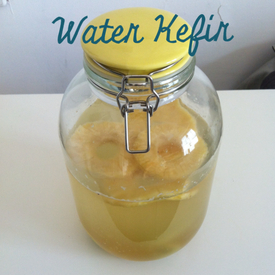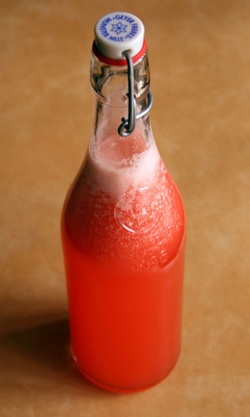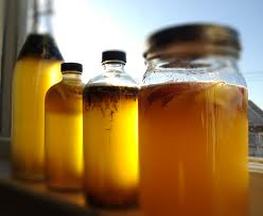 Pineapple Water Kefir brewing on my counter.
Pineapple Water Kefir brewing on my counter. More than likely you have heard about probiotics in yogurt, kombucha, or sourdough bread. But what in the heck are they and why should you consume them? The root of word pro-biotic literally means "promotes-life". Probiotics are alive and usually manifest as good bacteria which are vital to your gut. An estimated 100 trillion microorganisms inhabit every normal, healthy bowel. I know! I know! It sounds kinda gross but without these good bacteria we would not be able to to maintain optimal health, digestion or prevent and remedy colds.
Due to our modern day life, pollution, emotional stress, the Standard American Diet (SAD), use of antibiotics (anti-life) and other drugs have shifted the balance of good to bad bacteria. This shift of good to bad bacteria in your gut has been related to fatigue, urinary tract infections, muscle pain and diarrhea. Consuming good bacteria in the form of probiotics helps to remedy these problems as well as aid in nutrient absorption.
Probiotics are also known to strengthen your immune system which protects us form germs. Pretty important! If your immune system is weak due to a lack of good bacteria you may become vulnerable to catching more colds, allergic reactions and numerous autoimmune disorders (Crohn's & IBS). Lucky for us the balance of good to bad bacteria can be restored... and I have a few tasty recipes to help you out.
Kombucha is a very trendy (and expensive!) drink these days. Aside from being the hippest kid on the beverage shelf this ancient tonic is loaded with all those good bacteria, over 50 probiotics and digestive enzymes you are looking for to give you Super Man or Woman digestion and immunity! The only downside to buying kombucha is the price, which is why I started making it at home. Kombucha is a fermented fizzy tea made with a starter SCOBY (Symbiotic Culture of Bacteria and Yeast also known in kombucha lingo as the mushroom or mother), tea prepared with organic cane sugar, and some kombucha tea from a previous batch. The mixture is allowed to ferment at room temperature for 5 to 30 days. It can be consumed plain or with added flavoring such as fruit or juice and contains a number of vitamins, particularly B vitamins. (See my recipe below)
Another probiotic drink is water kefir. Although lesser known than kombucha, water kefir provides many of the same probiotic benefits and in my opinion is easier to make. Water kefir is a probiotic beverage made with water kefir grains and sugar water, juice, or coconut water which can be flavored with juice, fresh or dried fruit. Water kefir grains harbor a set of bacteria and yeast existing in a symbiotic relationship. The term "kefir grains" describes the look and shape of the culture only. Their are no actual "grains." While water kefir contains a greater number of bacterial strains than are found in kombucha, kombucha also contains some acids and enzymes to aid in the breaking down of your meals. So take your pick or make both and decide for yourself! If drinking fermented tea or probiotic drinks isn't your thing you can just pop the pill. Dr. Mercola makes a great probiotic you can get here.
Due to our modern day life, pollution, emotional stress, the Standard American Diet (SAD), use of antibiotics (anti-life) and other drugs have shifted the balance of good to bad bacteria. This shift of good to bad bacteria in your gut has been related to fatigue, urinary tract infections, muscle pain and diarrhea. Consuming good bacteria in the form of probiotics helps to remedy these problems as well as aid in nutrient absorption.
Probiotics are also known to strengthen your immune system which protects us form germs. Pretty important! If your immune system is weak due to a lack of good bacteria you may become vulnerable to catching more colds, allergic reactions and numerous autoimmune disorders (Crohn's & IBS). Lucky for us the balance of good to bad bacteria can be restored... and I have a few tasty recipes to help you out.
Kombucha is a very trendy (and expensive!) drink these days. Aside from being the hippest kid on the beverage shelf this ancient tonic is loaded with all those good bacteria, over 50 probiotics and digestive enzymes you are looking for to give you Super Man or Woman digestion and immunity! The only downside to buying kombucha is the price, which is why I started making it at home. Kombucha is a fermented fizzy tea made with a starter SCOBY (Symbiotic Culture of Bacteria and Yeast also known in kombucha lingo as the mushroom or mother), tea prepared with organic cane sugar, and some kombucha tea from a previous batch. The mixture is allowed to ferment at room temperature for 5 to 30 days. It can be consumed plain or with added flavoring such as fruit or juice and contains a number of vitamins, particularly B vitamins. (See my recipe below)
Another probiotic drink is water kefir. Although lesser known than kombucha, water kefir provides many of the same probiotic benefits and in my opinion is easier to make. Water kefir is a probiotic beverage made with water kefir grains and sugar water, juice, or coconut water which can be flavored with juice, fresh or dried fruit. Water kefir grains harbor a set of bacteria and yeast existing in a symbiotic relationship. The term "kefir grains" describes the look and shape of the culture only. Their are no actual "grains." While water kefir contains a greater number of bacterial strains than are found in kombucha, kombucha also contains some acids and enzymes to aid in the breaking down of your meals. So take your pick or make both and decide for yourself! If drinking fermented tea or probiotic drinks isn't your thing you can just pop the pill. Dr. Mercola makes a great probiotic you can get here.

How To Make WATER KEFIR
- Half gallon size jar
- 1/4 Cup organic cane sugar or Organic Coconut Sugar
- 6 Cups of Filtered/Spring Water2-3 pieces of unsweetened dried fruit (I like figs, mango, or pineapple)
- Water Kefir Grains
- Mix the water and sugar until sugar is completely dissolved. If you have to heat the water make sure to let it cool down to room temperature before you add the kefir grains.
- Add the fruit and kefir grains to the water sugar mixture.
- Cap loosely and let sit out at room temperature for 48 hours.
- Once fermented it should bubble slightly like soda. Depending on how sweet or tart you want your brew you may leave the grains in another day or two.
- Strain the grains and remove the fruit.
- Rinse the grains with water and store in the refrigerator or transfer them to a new solution. The grains should grow and a produce more grains with each fermentation.
- Water kefir keeps refrigerated for one week.

How To Brew KOMBUCHA: Adapted From Wellness Mama
Note: It is very important that all materials and surfaces are very clean and that your hands have been washed before starting this process!
- A gallon size glass jar
- 1 gallon of brewed tea – Must be cooled to room temperature!
- 1 cup organic cane sugar
- 1 Kombucha scoby (from a starter kit or the "baby" from another scoby mother)
- a kitchen towel/coffee filter/cheese cloth and a rubber band
Note: It is very important that all materials and surfaces are very clean and that your hands have been washed before starting this process!
- Prepare the tea (1 cup organic sugar to 1 gallon of brewed tea) Use 8-10 regular size tea bags or fill a reusable tea bag with loose tea.
- Let the tea cool and remove tea bags. Make sure that tea is completely cool before going on to next step.
- Pour the tea into a gallon size glass jar, leaving at least an inch of room at the top.
- Add 1 cup of liquid from a previous batch of Kombucha or from a store bought bottle of Kombucha. You only have to do this step for you first brew, afterwards you can just use some tea from your previous brew.
- Place the Kombucha SCOBY at the top of the liquid. It should float, but don’t stick your hands into the tea to get it to float!
- Cover the jar with a coffee filter or towel and secure with a rubber band.
- Place in a warm location (around 70-75 degrees) and let sit from 5-30 days depending on your preference. It will ferment faster the warmer it is and be less sweet and more potent the longer you leave it.
- When it is finished brewing you can store in smaller jars or in another big jar with a lid and repeat the brewing process with the SCOBY to make more batches. Every 1-2 batches, the SCOBY will have a baby that can be used to make other batches or given away.
- Keeps refrigerated for one week.

